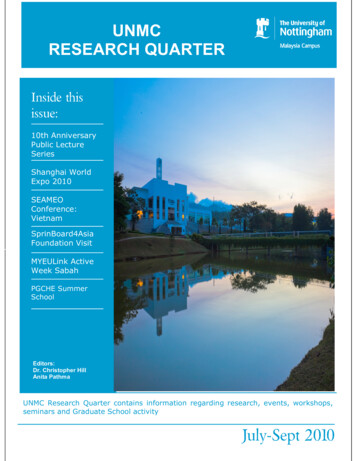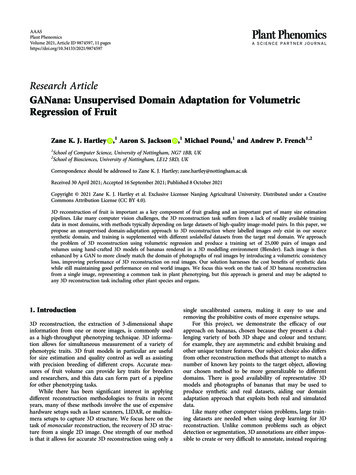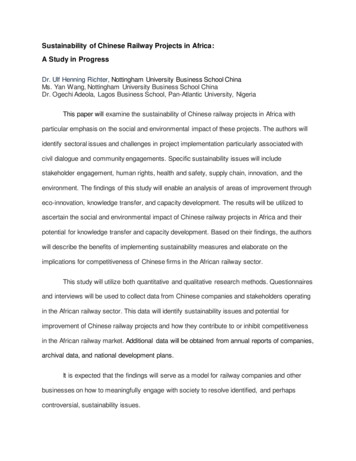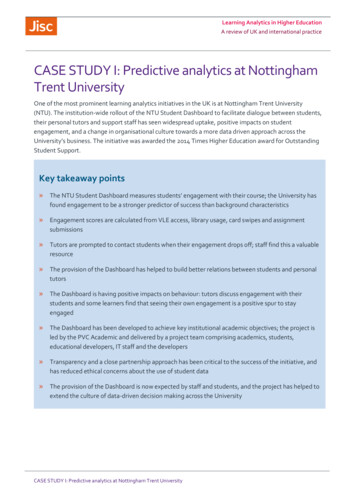
Transcription
Discussion Paper No. 2010‐18Robin P. Cubitt,Michalis Drouvelis,Simon Gächterand Ruslan KabalinOctober 2010Moral Judgments in SocialDilemmas: How Bad is FreeRiding?CeDEx Discussion Paper SeriesISSN 1749 ‐ 3293
The Centre for Decision Research and Experimental Economics was founded in2000, and is based in the School of Economics at the University of Nottingham.The focus for the Centre is research into individual and strategic decision-makingusing a combination of theoretical and experimental methods. On the theory side,members of the Centre investigate individual choice under uncertainty,cooperative and non-cooperative game theory, as well as theories of psychology,bounded rationality and evolutionary game theory. Members of the Centre haveapplied experimental methods in the fields of public economics, individualchoice under risk and uncertainty, strategic interaction, and the performanceof auctions, markets and other economic institutions. Much of the Centre's researchinvolves collaborative projects with researchers from other departments in the UKand overseas.Please visit http://www.nottingham.ac.uk/economics/cedex/ for more informationabout the Centre or contactKarina TerryCentre for Decision Research and Experimental EconomicsSchool of EconomicsUniversity of NottinghamUniversity ParkNottinghamNG7 2RDTel: 44 (0) 115 95 15620Fax: 44 (0) 115 95 14159karina.terry@nottingham.ac.ukThe full list of CeDEx Discussion Papers is available rs/index.html
Moral Judgments in Social Dilemmas:How Bad is Free Riding?Robin P. Cubitt, University of NottinghamMichalis Drouvelis, University of BirminghamSimon Gächter, University of Nottingham * , CESifo and IZA,Ruslan Kabalin, University of Lancaster4th October 2010Forthcoming in: Journal of Public EconomicsSpecial Issue: Sen's 75th - New Directions in WelfareIn the last thirty years, economists and other social scientists have investigatedpeople’s normative views on distributive justice. Here we study people’s normativeviews in social dilemmas, which underlie many situations of economic and socialsignificance. Using insights from moral philosophy and psychology we provide ananalysis of the morality of free riding. We use experimental survey methods toinvestigate people’s moral judgments empirically. We vary others’ contributions, theframing (“give-some” vs. “take-some”) and whether contributions are simultaneous orsequential. We find that moral judgments of a free rider depend strongly on others’behaviour; and that failing to give is condemned more strongly than withdrawing allsupport.Keywords: moral judgments, moral psychology, framing effects, public goodsexperiments, free riding.*Corresponding author. School of Economics, Sir Clive Granger Building, University Park,Nottingham NG7 2RD, United Kingdom. Email: simon.gaechter@nottingham.ac.uk. Phone: 44-1158466132.1
1. IntroductionProminent among Amartya Sen’s many enduring contributions are hisarguments for enrichment of the concept of agency used in economic analysis and ofthe information base of welfare economics. 1 Although these arguments suggest thatan individual’s normative views may be relevant both to the explanation of herbehaviour and to her evaluations of states of affairs, they also suggest that it may behard to infer normative views directly from choice behaviour.A striking recent development in public economics, reflecting this difficulty,has been increasing use of data on people’s normative attitudes obtained with surveysor questionnaires. For example, views about distributive justice and redistributivepolicy have been examined by Fong (2001), Gaertner et al. (2001), Corneo andGrüner (2002), Faravelli (2007), Gaertner and Schwettmann (2007), and Corneo andFong (2008). 2 In this paper, we extend the empirical investigation of normative viewsto a different economic context, namely social dilemma (public goods) games, and adifferent type of normative view, namely moral judgment. 3 More specifically, wereport an experiment that, using techniques adapted from moral psychology, exploreshow people judge the morality of a free rider in a social dilemma game.A social dilemma arises when members of a group share the benefits of a commonresource but each has to decide individually how much to contribute to its provision.Contribution is costly to the contributor but helps all other group members. Thus, asocial dilemma isolates a conflict between personal interest, which militates for freeriding, and collective interest, which requires contribution. The ubiquity of socialdilemmas makes them important for economics and social science; and the conflict ofinterest they embody makes them potentially fruitful ground for the empirical study ofmoral judgments. In fact, there are arguments to the effect that the conception ofmorality itself evolved in response to cooperation problems our ancestors faced. 4Previous research has shown that people experience negative emotions towardsfree riders in social dilemmas and that some are willing to incur costs to punish them. 5However, little is known about people’s moral judgment of free riders. Although it1See, for example, the essays collected in Sen (1982a)and Sen (2002).See Konow (2003) and Gaertner (2009) for overviews.3Moral judgments can be “defined as evaluations (good vs. bad) of the actions or character of a personthat are made with respect to a set of virtues held to be obligatory by a culture or subculture” (Haidt(2001), p. 817).4e.g. Ridley (1996); Binmore (2005); Hauser (2006); Gintis et al. (2008), Krebs (2008).5e.g. Fehr and Gächter (2000); Fehr and Gächter (2002); Fehr and Fischbacher (2004); Cubitt et al.(2008); Gächter and Herrmann (2009).22
seems that many people dislike free riders when directly affected by their behaviour,it does not follow that free riding is viewed as morally reprehensible. Croson andKonow (2009) provide evidence of a difference between normative judgmentsreached from the standpoints of “stakeholder” and impartial observer in dictatorgames; and the same difference could apply in social dilemmas. We ask: whenjudgment is not confounded with self-interest from being an affected party, is freeriding still judged to be wrong? And, if so, what factors influence how severe atransgression it is seen as?In our study, subjects (n 538) were confronted with hypothetical scenariosinvolving a two-player public goods game in which one player free rides. For eachscenario, subjects were asked to express their positive or negative moral rating of thefree rider, without themselves being involved in the decision situation. As they weremerely observers, their judgments should represent impartial moral evaluations.Our experimental design manipulates three aspects of the scenarios. First, wemanipulate the behaviour of the non-judged player to see whether subjects’ moraljudgments of the free rider depend on this. Our second manipulation investigates howmoral judgments depend on the order of moves in the scenarios. In particular, weexplore whether the sensitivity of judgments of the free rider to the action of the nonjudged player is affected by whether the free rider knew the other player’s behaviourwhen choosing his own. Third, we explore whether moral judgments are sensitive tocontextual cues provided by the framing of the decision problem. The framingmanipulation we study has a Give versus Take form. This manipulation is common instudies of social dilemma games, 6 but its impact on moral judgments in that contexthas not been studied before, to our knowledge.We find that that free riding is perceived as a morally blameworthy action in allour scenarios, except for one case in which it is seen as morally praiseworthy. Theexceptional case is the one, which we will call “ratting on a rat”, in which the judgedfree rider moves second, after observing that the other player has free ridden too. Weprovide evidence that, irrespective of whether moves are simultaneous or sequential,the higher is the other player’s contribution, the more negative is the moral ratingassigned to the free rider on average. Interestingly, this pattern of judgments is also6See, for example, Brewer and Kramer (1986); McDaniel and Sistrunk (1991); Andreoni (1995);McCusker and Carnevale (1995); Sell and Son (1997); Sonnemans et al. (1998); Park (2000); van Dijkand Wilke (2000); Rege and Telle (2004); and Dufwenberg et al. (2010).3
observed at an individual level for a substantial minority of subjects in thesimultaneous case and for an overwhelming majority in the sequential case. Finally,we find a strong framing effect in moral evaluations: other things equal, subjectscondemn withdrawing support from the public good less than the correspondingequivalent action of failing to contribute to it.We see these findings as a contribution not just to economics but also to theemerging literature in moral psychology and empirical moral philosophy (Haidt(2001), Nichols (2004), Haidt (2007), Nado et al. (2009)). This literature investigateshow people arrive at moral judgments in a number of contexts. By extending it tocover free riding in social dilemmas, we make a contribution that is both conceptualand empirical. We analyse a typical experimental social dilemma problem from theperspectives of two accounts of how people form moral judgments: the reason-basedmodel and the emotion-based model.Although our experimental design is notintended to test between those models, each model provides a distinct framework foranalysing how our experimental manipulations may affect moral judgments. Weexplain this in Section 3, after describing our main design features in Section 2.Section 4 gives details of experimental procedures. Finally, Section 5 presents, andSection 6 discusses, our empirical results. 72. Experimental design: scenarios and treatmentsIn our experiment, each subject responded to a questionnaire requiring her toreport her moral judgment of a player in hypothetical scenarios. There were fourtreatments, each defined by a different questionnaire. Each subject responded to thequestionnaire for one treatment only.Each questionnaire described a decision problem for two fictitious players, namedPerson A and Person B; and then gave some possible endings, each of which specifiedplayers’ choices and their consequences. A scenario comprises a description of adecision problem and an ending. Each questionnaire consisted of five scenarios withthe same decision problem, but different endings.In all scenarios, the players were the two members of a group playing a publicgood game. Within each questionnaire, the behaviour of Person A varied acrossscenarios but Person B was always a complete free-rider. After each ending, the7For readers more interested in the empirical contribution than the conceptual one, it is possible toskip or skim Section 3, though doing so carries a cost in terms of understanding parts of Section 6.4
subject was asked, as a detached observer, to rate the morality of Person B on a scaleranging from -50 (extremely bad) to 50 (extremely good). Thus, in each treatment,we can test within-subjects for the impact of the behaviour of the non-judged playeron the moral rating assigned to the free rider. All other tests are between-subjects andinvolve comparisons of subjects’ responses across treatments.There were two treatment variables: the framing used to describe the decisionproblem; and the order of moves in that problem. Each variable had two possiblevalues: “Give” and “Take” for framing; and “Simultaneous” and “Sequential” fororder of moves. Each was manipulated independently, yielding four treatments: GiveSimultaneous, Take-Simultaneous, Give-Sequential, and Take-Sequential.To explain the Give versus Take manipulation, we fix on the Simultaneous orderof moves. In the Give frame, the decision facing each player was how much tocontribute to a group project; in the Take frame, it was how much to withdraw. Thefirst scenarios in the Give-Simultaneous and Take-Simultaneous treatments are shownin the left-hand and right-hand columns below respectively. (To show the differencebetween them, we present corresponding Give and Take scenarios side by side here,using bold face for each phrase which differs from the corresponding one in the otherframing. However, bold face was not used for these passages when scenarios werepresented to subjects and, as explained above, no subject saw both frames).Give-SimultaneousTake-SimultaneousImagine a group that consists of two groupmembers, Person A and Person B. Each groupmember receives an endowment of 20 tokens andhas to decide how many tokens to keep forhimself and how many to contribute to a groupproject. Each token he keeps for himself has avalue of one pound for him.Each tokencontributed to the group project has a value of1.50 pounds to the project. The total value of theproject is divided equally between the two groupmembers.So, each token contributed to theproject earns both group members 0.75 poundseach. The total income of a group member is thesum earned from tokens kept for himself and hisshare of the earnings of the group project. Eachgroup member decides simultaneously, that is,without knowing what the other one has done.Imagine a group that consists of two groupmembers, Person A and Person B. There are 40tokens in a group project. Each group memberhas to decide how many, up to a maximum of 20,of these tokens to withdraw for himself and howmany to leave in the group project. Each tokenhe withdraws for himself has a value of onepound for him. Each token left in the groupproject has a value of 1.50 pounds to the project.The total value of the project is divided equallybetween the two group members. So, each tokenleft in the project earns both group members 0.75pounds each. The total income of a groupmember is the sum earned from tokens withdrawnby himself and his share of the earnings of thegroup project. Each group member decidessimultaneously, that is, without knowing what theother one has done.A) Assume that Person A contributes 0 tokens tothe group project and Person B contributes 0tokens to the group project. Therefore, the valueof the group project is 0 pounds and, thus, as aresult of their contributions, Person A’s totalA) Assume that Person A withdraws 20 tokensfrom the group project and Person B withdraws20 tokens from the group project. Therefore, thevalue of the group project is 0 pounds and, thus,as a result of their withdrawals, Person A’s total5
income is 20 pounds and Person B’s total incomeis 20 pounds.income is 20 pounds and Person B’s total incomeis 20 pounds.The scenarios within each questionnaire differed from each other only in PersonA’s behaviour. In the Give-Simultaneous treatment, Person A’s contribution was 0tokens (as shown) in the first scenario, rising to 20 in increments of 5 over the otherfour scenarios. In the Take-Simultaneous treatment, Person A’s withdrawal was 20tokens (as shown) in the first scenario, declining to 0 in decrements of 5 over the otherfour scenarios. In all scenarios, the last sentence specified the incomes to Person Aand Person B resulting from their joint behaviour; and then the subject was asked“How do you rate Person B’s morality?” (bold face in original).The Give and Take frames differ only in the description of the scenarios. There isno difference in terms of the feasible sets of monetary outcomes available to a playerin corresponding scenarios In each frame, each player controlled the final destinationof 20 tokens, each of which could be allocated either to himself (earning 1 for him)or to the project (earning 0.75 for each player). In view of this, we use the term“effective contribution” below to refer to the tokens allocated by a player to theproject, regardless of whether this was by means of contributing or not withdrawing.In addition to the Simultaneous treatments, we ran two treatments (one with theGive frame, and one with Take) in which the non-judged player moved first. Eachquestionnaire for these Sequential treatments was obtained from the correspondingSimultaneous one by replacing the last sentence of the first paragraph with “Assumethat Person A decides first and Person B observes Person A’s choice before makinghis own decision.” In all other respects, Sequential questionnaires were identical tothe corresponding Simultaneous ones.3. Discussion of design from the perspective of moral psychology and philosophyThe philosophical and psychological literatures suggest two broad accounts ofhow individuals might arrive at their moral judgments which, for convenience, we callthe reason-based model and the emotion-based model, respectively. 88The reason-based model can be seen as a descendent of rationalist traditions in philosophy associatedwith Descartes, Leibniz and Kant. (However, it is important that what we call here the reason-basedmodel does not require agents to endorse Kantian moral principles.) The emotion-based model hasmore affinity with naturalistic traditions in philosophy associated with Hume and Smith. For morerecent discussions of the philosophical and psychological background on moral judgments, see e.g.,Haidt (2001); Nichols (2004); Doris and Stich (2005); Hauser (2006); Joyce (2006); Prinz (2006); Prinz(2007); Krebs (2008); Sinnott-Armstrong (2008); DeScioli and Kurzban (2009); Nado et al. (2009).6
The reason-based model sees an individual’s moral judgments as the result ofdeliberation in which the prior moral principles she endorses are applied to the case athand. On this account, hypotheses about how subjects’ judgments will vary acrossscenarios would be conditional on assumptions about their prior moral principles and,in particular, about whether those principles imply that the differences between ourscenarios are morally relevant.In contrast, the emotion-based model sees emotions and intuitions as the driversof moral judgments. On this view, moral judgments express sentiments, caused byquickly-formed moral intuitions which may be followed by ex post moral reasoning. 9On the emotion-based model, whether and how far subjects report different judgmentsacross scenarios would depend on whether there are differences in the nature andintensity of the emotional responses cued by them.To facilitate our discussion of how our experimental manipulations would be seenby these two models of judgment, we begin by giving names to certain hypotheses.We refer to the view that moral judgments are insensitive to the Give versus Takemanipulation as the frame insensitivity hypothesis.Correspondingly, the independence hypothesis asserts that the moral rating ofPerson B is independent of Person A’s effective contribution.Note that theindependence hypothesis could hold in either Simultaneous or Sequential treatments,but (as we will see) the arguments that would motivate it in the two cases may bedifferent. If the independence hypothesis holds under one order of moves, but not theother, this would induce a difference between Sequential and Simultaneous treatmentsfor some otherwise identical scenarios.If judgments of Person B are sensitive to Person A’s effective contribution, itseems most likely that this will take the form that the higher is Person A’s effectivecontribution, the less favourable is the moral rating assigned to Person B. We refer tothis as the increasing condemnation hypothesis. We focus on this (potential) directionof effect as, although Person B’s effective contribution is always 0 tokens, theeffective contribution of Person A rises across the successive endings of eachquestionnaire, leading to outcomes that are progressively less favourable to Person Aand more favourable to Person B, both in relative and absolute terms. Each incrementof 5 tokens in Person A’s effective contribution reduces Person A’s monetary payoff9For experimental evidence, see Greene et al. (2001) and Wheatley and Haidt (2005). For overviews,see Haidt (2001); Greene and Haidt (2002) and Haidt (2007).7
by 1.25, while increasing that of Person B by 3.75. Thus, although each playerreceives 20 in the first scenario of each questionnaire, by the last scenario, Person Areceives 15 and Person B 35.The reason-based modelThe implications of the reason-based model depend on the prior ethical principlesthat subjects endorse and, especially, on whether these are consequentialist. 10For a consequentialist ethical theory, the moral value of an action derives fromcomparison of its consequences with other feasible ones; so re-describing the decisionproblem, holding actual and feasible consequences constant, should have no impacton the moral value of the action. Thus, if our subjects endorse any form ofconsequentialism that sees the morally relevant consequences in our scenarios asdetermined by the monetary outcomes, the reason-based model predicts that the frameinsensitivity hypothesis will hold.For the remainder of the paper, by“consequentialism” we intend a form of the doctrine that has this implication.11 Thus,if we observe a difference between judgments in the Give and Take frames, thereason-based model would have to interpret it as evidence of subjects endorsing priorethical principles that are not consequentialist in the sense just described.The consequentialist argument for frame insensitivity requires the morallyrelevant consequences of Person B’s free-riding to be determined by the monetaryoutcomes, but it does not depend on how broadly those outcomes are construed.If they take a narrow view, subjects could see the consequences of Person B’saction as consisting only of the payments determined by the tokens in his own control.This would imply that the “consequence” of Person B making an effectivecontribution of zero tokens is the same across all scenarios. Then, in addition toframe insensitivity, the independence hypothesis would hold in Simultaneous10Blackburn (2008), p. 74, defines consequentialism as the view that the “value of an action derivesentirely from its consequences”. For an extensive philosophical discussion, see Sinnott-Armstrong(2006); for a discussion from an economic point of view see Sen (1987).11When faced with counter-examples, a possible defensive move for advocates of consequentialismmight reinterpret consequences to include factors previously not seen as part of them. If “contributingno tokens” and “withdrawing 20 tokens” are interpreted as acts with different consequences, perhapsbecause only one leads to the “consequence” that a withdrawal has been made, then a framing effect inour design would be compatible with subjects making consequentialist judgments, in the reinterpretedsense. However, taken to the limit, this reinterpretation strategy risks abolishing any distinctionbetween an action and its consequences, so rendering consequentialism trivial.8
treatments, and in Sequential treatments, and with no difference betweenSimultaneous and Sequential.However, if subjects take a broad view and see the consequences of Person B’sfree riding as including all monetary payments that arise in a given scenario, theindependence hypothesis might fail (at least in Sequential treatments). For example,it would be consistent with a broad view for the difference between (or ratio of) thepayoffs to each player to be seen as a morally-relevant feature of the consequences ofPerson B’s free riding. If subjects are consequentialist in the broad sense, and averseto unequal outcomes, this creates the potential for the increasing condemnationhypothesis to hold. Any increase in Person A’s effective contribution tilts relativepayoffs (further) in Person B’s favour, if Person B continues to free ride. If this isseen as an undesirable outcome, then the obligation on Person B to avoid it maystrengthen; and, if so, one would expect Person B to be condemned more strongly forcontinuing to free ride. Thus, broad consequentialism can generate, out of an attitudetowards unequal outcomes, a view that Person B ought to match Person A’s effectivecontribution.If subjects reason in this way, one might expect the increasingcondemnation hypothesis to hold in Sequential treatments, since Person B must beheld responsible for (what a broad consequentialist sees as) the different, and known,consequences of his actions across the five scenarios in a Sequential treatment.It is harder to formulate moral principles that rationalise conformity with theincreasing condemnation hypothesis in Simultaneous treatments, as they would haveto license condemning Person B differently, given different effective contributions byPerson A, even though Person B is neither responsible for nor knows Person A’schoice. We will call the principle that an agent cannot be condemned on the basis ofmatters which he neither controls nor knows the responsibility doctrine. If subjectsendorse this principle then, even if they are otherwise inclined to view consequencesbroadly, the independence hypothesis would hold in Simultaneous treatments.However, there are ethical views which violate the responsibility doctrine andmight account for increasing condemnation even in Simultaneous treatments. At firstsight, this may seem a strange property for moral principles. But, within a broadconsequentialist framework, rationalisation for it can be found in the doctrine ofmoral luck, discussed by Nagel (1976) and Williams (1981).According to this doctrine, an agent can be blamed for outcomes of their actionsto which chance, or other matters outside their control, have contributed. As an9
example, Nagel argues that a driver who has negligently failed to check his brakes“would have to blame himself” (emphasis added) much more if a child runs into theroad and is killed than if no situation arises which requires sharp braking, even thoughhis negligence is the same in each case, and he neither predicted nor had any controlover the child’s action. By analogy, in the current context, one might see it as badmoral luck for Person B if Person A makes a non-zero effective contribution, soturning his own free riding into unilateral free-riding (and worse moral luck thehigher is Person A’s effective contribution). Then, the moral luck doctrine wouldlicense blaming Person B more, as Person A’s effective contribution rises.Finally, note that there is nothing in the reason-based model that requires subjectsto be consequentialist. If subjects endorse deontological moral principles instead,then the reason-based model predicts that they would apply those principles to formtheir judgments. Deontological views see the moral status of an action as flowing, notfrom its consequences, but from its intrinsic properties. For example, it might be seenas intrinsically wrong to commit murder even if, by some bizarre twist of fate, onecould bring about net beneficial consequences by doing so.In our context, if the intrinsic properties of Person B’s free riding are to bedistinguished from consequences, it seems inevitable that they can take no account ofPerson A’s action when Person B is unaware of it. Thus, deontological forms of thereason-based model would lead us to expect the independence hypothesis to hold inSimultaneous treatments.Whether it would also hold in Sequential treatments would depend on whetherthe intrinsic properties of Person B’s free riding are sensitive to Person A’s choice,when that is known to Person B. If not (for example, because free riding is seen asintrinsically and unconditionally wrong) then the independence hypothesis would beexpected to hold in Sequential treatments, as well as in Simultaneous. But, a differentview might rationalise increasing condemnation, for example if taking revenge onPerson A when he has free ridden, or failing to reward him when he has contributed,are seen as intrinsic properties of Person B’s free riding in different scenarios. If theformer is morally acceptable but the latter is not then this view would require theincreasing condemnation hypothesis, but only in Sequential treatments.Finally, if withdrawing and withholding support are seen as intrinsically differentactions, application of deontological moral principles could also account for framesensitivity of judgments of the free rider.10
The emotion-based modelOn the emotion-based model, it is not necessary to delve into such tricky terrainto account for violations of frame insensitivity and/or the independence hypothesis,because the model does not require moral judgments to flow from coherent principles.Instead, it sees them as cued by emotional responses to the scenario as a whole.Evolutionary theorists argue that moral judgments may be situation-specific andframe-dependent (e.g., Krebs (2008), p. 116). Consistent with this argument, theemotion-based model suggests that subjects’ judgments would be driven by gutreactions to whole scenarios which, in turn, may be sensitive to seemingly incidentalfeatures of them. For example, the emotional response to a player whose effectivecontribution is zero might differ according to whether this free riding arises fromcomplete failure to contribute to the project or from maximal withdrawal of supportfrom it. This is possible even though the consequences are the same, and even in theabsence of a prior ethical theory that licenses the distinction.Similarly, it is easy to imagine how Person A’s choice might affect a subject’semotional response to a scenario in which Person B free rides, even when theirchoices are simultaneous.The subject might be more angered, or disgusted, orsaddened, by a scenario in which Person B free rides the larger is Person A’s effectivecontribution. For example, negative emotional responses to payoff inequality or toinequality of contributions could bring this about.Although it is possible that emotional responses would vary betweenSimultaneous and Sequential versions of otherwise identical scenarios, the emotionbased model need not confine the increasing condem
sequential. We find that moral judgments of a free rider depend strongly on others' behaviour; and that failing to give is condemned more strongly than withdrawing all support. Keywords: moral judgments, moral psychology, framing effects, public goods experiments, free riding. * Corresponding author. School of Economics, Sir Clive Granger .










